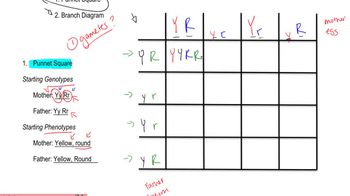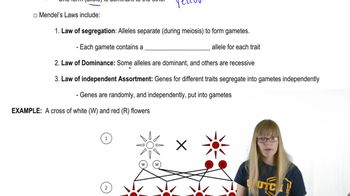For the cross Aabb × aaBb, what is the expected genotype ratio? What is the expected phenotype ratio?
Table of contents
- 1. Introduction to Genetics51m
- 2. Mendel's Laws of Inheritance3h 37m
- 3. Extensions to Mendelian Inheritance2h 41m
- 4. Genetic Mapping and Linkage2h 28m
- 5. Genetics of Bacteria and Viruses1h 21m
- 6. Chromosomal Variation1h 48m
- 7. DNA and Chromosome Structure56m
- 8. DNA Replication1h 10m
- 9. Mitosis and Meiosis1h 34m
- 10. Transcription1h 0m
- 11. Translation58m
- 12. Gene Regulation in Prokaryotes1h 19m
- 13. Gene Regulation in Eukaryotes44m
- 14. Genetic Control of Development44m
- 15. Genomes and Genomics1h 50m
- 16. Transposable Elements47m
- 17. Mutation, Repair, and Recombination1h 6m
- 18. Molecular Genetic Tools19m
- 19. Cancer Genetics29m
- 20. Quantitative Genetics1h 26m
- 21. Population Genetics50m
- 22. Evolutionary Genetics29m
2. Mendel's Laws of Inheritance
Dihybrid Cross
Problem 8a
Textbook Question
Determine whether the statements below are true or false. If a statement is false, provide the correct information or revise the statement to make it correct.
If a dihybrid cross is performed, the expected genotypic ratio is 9:3:3:1.
 Verified step by step guidance
Verified step by step guidance1
Understand the context of the problem: A dihybrid cross involves two traits, each controlled by a pair of alleles, and follows Mendel's laws of inheritance. The expected phenotypic ratio for a dihybrid cross is 9:3:3:1, not the genotypic ratio.
Recall the difference between phenotypic and genotypic ratios: The phenotypic ratio refers to the observable traits, while the genotypic ratio refers to the genetic makeup (allele combinations) of the offspring.
Analyze the statement: The statement claims that the expected genotypic ratio for a dihybrid cross is 9:3:3:1. This is incorrect because 9:3:3:1 is the phenotypic ratio, not the genotypic ratio.
Determine the correct genotypic ratio: For a dihybrid cross (e.g., AaBb x AaBb), the genotypic ratio is more complex and includes combinations such as AABB, AaBB, AABb, AaBb, etc. You would need to calculate the frequencies of each genotype using a Punnett square.
Revise the statement: The correct version of the statement is: 'If a dihybrid cross is performed, the expected phenotypic ratio is 9:3:3:1, while the genotypic ratio includes multiple combinations and is not represented by 9:3:3:1.'
 Verified video answer for a similar problem:
Verified video answer for a similar problem:This video solution was recommended by our tutors as helpful for the problem above
Video duration:
5mPlay a video:
Was this helpful?
Key Concepts
Here are the essential concepts you must grasp in order to answer the question correctly.
Dihybrid Cross
A dihybrid cross is a genetic cross that examines the inheritance of two different traits, each controlled by different genes. In this type of cross, individuals that are heterozygous for both traits are typically used, allowing for the analysis of how these traits segregate independently according to Mendel's law of independent assortment.
Recommended video:
Guided course

Punnet Square
Genotypic Ratio
The genotypic ratio refers to the relative frequency of different genotypes produced in the offspring from a genetic cross. In a dihybrid cross, the expected genotypic ratio is 1:2:1 for each trait, leading to a combined phenotypic ratio of 9:3:3:1 when considering both traits together, which reflects the variety of combinations of alleles.
Recommended video:
Guided course

Gamete Genotypes
Mendel's Laws of Inheritance
Mendel's laws of inheritance, particularly the law of segregation and the law of independent assortment, describe how alleles segregate during gamete formation. The law of segregation states that allele pairs separate during gamete formation, while the law of independent assortment states that the segregation of one pair of alleles is independent of the segregation of another pair, which is crucial for understanding the outcomes of dihybrid crosses.
Recommended video:
Guided course

Mendel's Laws
Related Videos
Related Practice
Textbook Question
936
views


